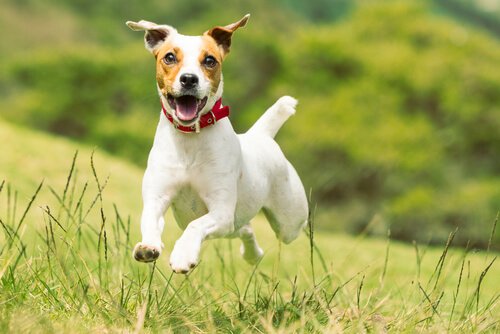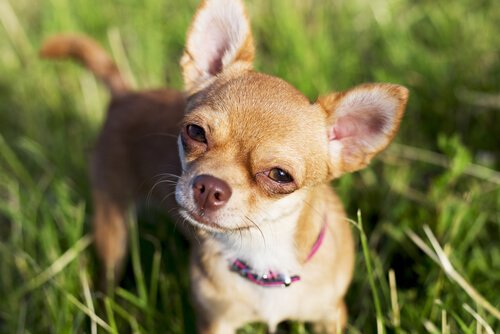Small Dogs: 6 Things You Should Know

More families, couples and single people are adopting small dogs now. A lot of times it’s because they live in apartments with tiny dimensions. The “mini” breeds are actually the most popular in the world. If you want to adopt a new “size XS” best friend, this article is for you.
Having a small dog

Why is it that you almost never see very large pets walking with their owners? Maybe they’re all in the country, because in the cities they are almost non-existent. Small dogs, between 5 and 20 pounds, are often chosen by those who live in urban areas. Why? Because they don’t need very much space.
Before adopting a dog (of any size), you should take certain issues into account, like the dimensions of the house, if you have other pets, and if there are small children. You should also consider your activities and how much time you can devote to a pet.
A few advantages of having small-breed dogs:
- It’s easy to transport them.
- They can live happily in small spaces.
- Food and personal items (like a bed) cost less.
As for the disadvantages:
- They may be hard to train.
- They can cost a lot to buy.
- Hyperactivity and “yapping” might be problems.
The most popular small breeds are Pomeranians, Chihuahuas, Boston Terriers, Parson Russell Terriers, Maltese Bichons, Shih Tzus, Bichon Frises, Dachshunds, Pekingese, Pugs, Toy Poodles, French Bulldogs, Yorkshire Terriers, Prague Ratters and Scottish Terriers.
Caring for small dogs
For small dogs, take special care with the following aspects:
1. Temperature changes
They tend to be quite sensitive to sudden temperature changes because they don’t have much fat under their skin, and of course because of their small size. Small breeds are more prone to hypothermia. In the winter, it’s not good to leave them outdoors, and even at home they may need to wear a coat.
2. Trimming their nails
Along with bathing them, brushing them and cleaning their eyes and ears, nail trimming is an essential part of taking care of a dog, especially if he’s small in size. Many of these pets are not in contact with nature and therefore can’t wear down their nails naturally (although they may scratch rugs or carpets). Having their nails long bothers them when they walk and can hurt them.
3. Food and calories
While it’s true that small dogs eat less than large dogs, it’s also true that the former require more calories and fewer separate feedings. Tiny breeds have a metabolism that uses up energy faster. Choose food specially designed for their size and their characteristics (for example, the size of their teeth).
4. Teeth
“Mini” dogs tend to suffer from more dental problems than larger breeds. Their mouths (especially for pugs and Pekinese) are more delicate and their teeth deteriorate faster. Brushing is essential for proper oral hygiene, as is taking them for an annual veterinary check up and feeding them the right kind of food.
5. Heart

60% of small dogs suffer from heart problems (mostly pathologies related to heart valves). After 10 years, the organ begins to weaken and does not pump enough blood. If your dog pants too much or gets tired after everyday activities, you should take him to the veterinarian for a check-up.
6. Barking and hyperactivity
Owners of small dogs agree that they are very active and noisy animals. Some may say that miniature races are “crazy” and unbearable, but it all depends on how they were trained when they were puppies. In situations where you aren’t at home for hours at a time, we recommend setting up the environment so they don’t feel so alone and bark the whole time.
More families, couples and single people are adopting small dogs now. A lot of times it’s because they live in apartments with tiny dimensions. The “mini” breeds are actually the most popular in the world. If you want to adopt a new “size XS” best friend, this article is for you.
Having a small dog

Why is it that you almost never see very large pets walking with their owners? Maybe they’re all in the country, because in the cities they are almost non-existent. Small dogs, between 5 and 20 pounds, are often chosen by those who live in urban areas. Why? Because they don’t need very much space.
Before adopting a dog (of any size), you should take certain issues into account, like the dimensions of the house, if you have other pets, and if there are small children. You should also consider your activities and how much time you can devote to a pet.
A few advantages of having small-breed dogs:
- It’s easy to transport them.
- They can live happily in small spaces.
- Food and personal items (like a bed) cost less.
As for the disadvantages:
- They may be hard to train.
- They can cost a lot to buy.
- Hyperactivity and “yapping” might be problems.
The most popular small breeds are Pomeranians, Chihuahuas, Boston Terriers, Parson Russell Terriers, Maltese Bichons, Shih Tzus, Bichon Frises, Dachshunds, Pekingese, Pugs, Toy Poodles, French Bulldogs, Yorkshire Terriers, Prague Ratters and Scottish Terriers.
Caring for small dogs
For small dogs, take special care with the following aspects:
1. Temperature changes
They tend to be quite sensitive to sudden temperature changes because they don’t have much fat under their skin, and of course because of their small size. Small breeds are more prone to hypothermia. In the winter, it’s not good to leave them outdoors, and even at home they may need to wear a coat.
2. Trimming their nails
Along with bathing them, brushing them and cleaning their eyes and ears, nail trimming is an essential part of taking care of a dog, especially if he’s small in size. Many of these pets are not in contact with nature and therefore can’t wear down their nails naturally (although they may scratch rugs or carpets). Having their nails long bothers them when they walk and can hurt them.
3. Food and calories
While it’s true that small dogs eat less than large dogs, it’s also true that the former require more calories and fewer separate feedings. Tiny breeds have a metabolism that uses up energy faster. Choose food specially designed for their size and their characteristics (for example, the size of their teeth).
4. Teeth
“Mini” dogs tend to suffer from more dental problems than larger breeds. Their mouths (especially for pugs and Pekinese) are more delicate and their teeth deteriorate faster. Brushing is essential for proper oral hygiene, as is taking them for an annual veterinary check up and feeding them the right kind of food.
5. Heart

60% of small dogs suffer from heart problems (mostly pathologies related to heart valves). After 10 years, the organ begins to weaken and does not pump enough blood. If your dog pants too much or gets tired after everyday activities, you should take him to the veterinarian for a check-up.
6. Barking and hyperactivity
Owners of small dogs agree that they are very active and noisy animals. Some may say that miniature races are “crazy” and unbearable, but it all depends on how they were trained when they were puppies. In situations where you aren’t at home for hours at a time, we recommend setting up the environment so they don’t feel so alone and bark the whole time.
This text is provided for informational purposes only and does not replace consultation with a professional. If in doubt, consult your specialist.








